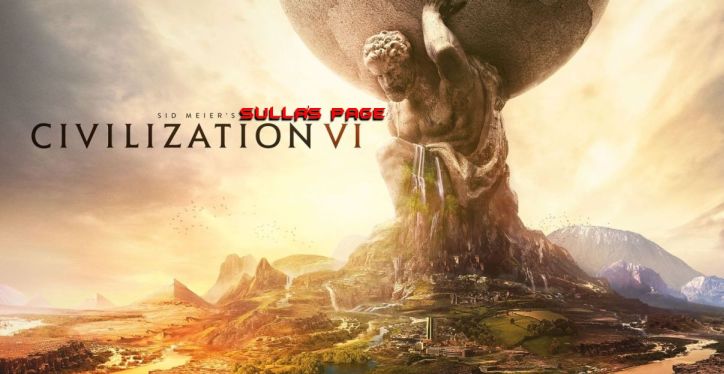
Click here to view with black text on white background

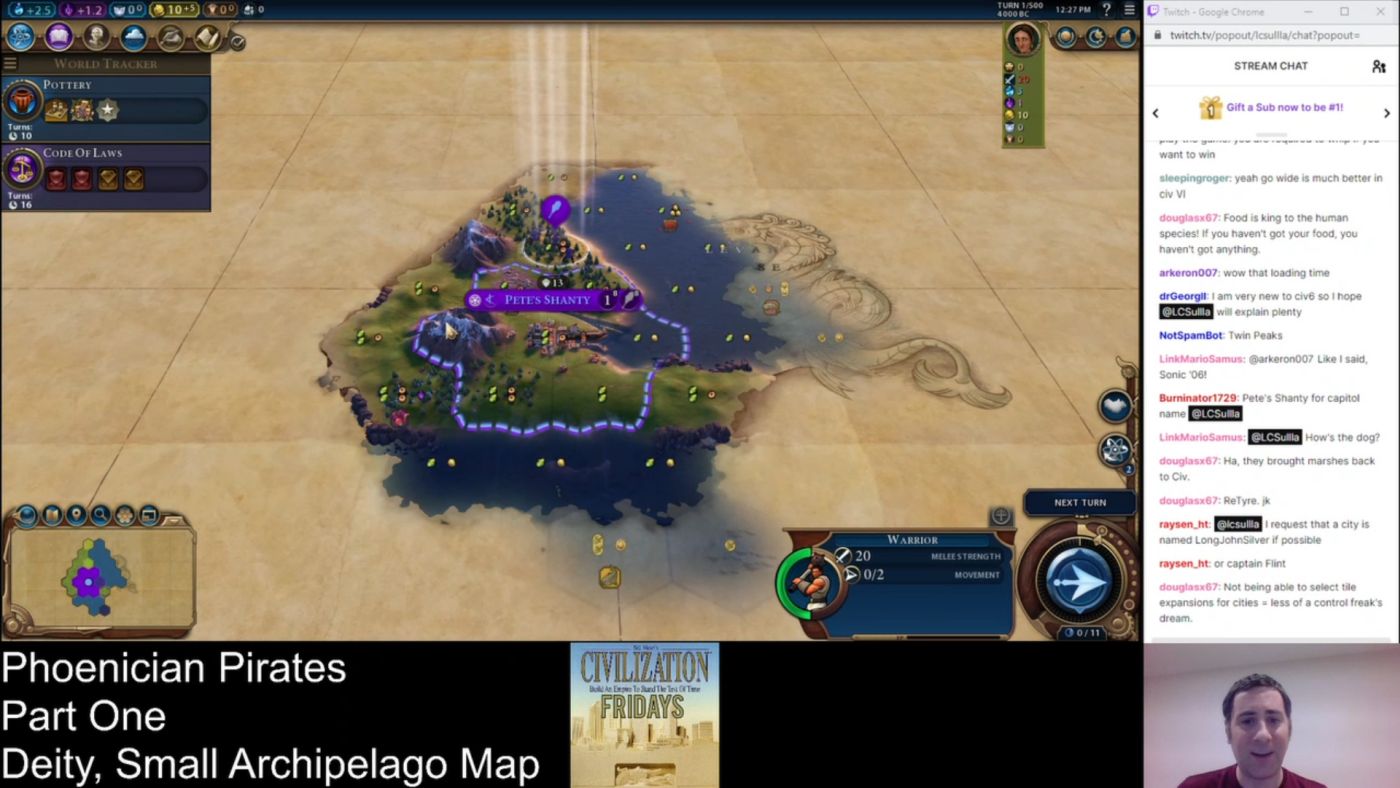
This is the short summary of a game that I played out on Livestream featuring the Phoenicians. I hadn't played Civ6 on stream for some time and decided that it would be fun to break out the game for a change of pace after running a series of Civ4 games. It's always somewhat amusing to me that Civ4 draws notably more viewers and interest than Civ6 but I do want to rotate in different strategy games for our Civ Fridays series to help keep things fresh. After playing a cultural game with Mansa Musa several months earlier, I decided that I would try an Archipelago map to emphasize the naval aspects of Civ6's gameplay. I also wanted to test out Phoenicia which has been used to excellent effect in some of the Realms Beyond Civ6 Multiplayer games, and I wanted to pursue a Domination victory because I had never achieved one of them in Civ6. (I could have done so easily in many games but wasn't interested in spending the time needed to capture all the capital cities.) I paired these ideas together and thus the "Phoenician Pirates" moniker for this game was born.
Phoenicia's big advantage in Civ6 is their unique district, the Cothon, a Harbor district with a series of extra bonuses. Cothons provide +50% production towards all naval units AND +50% production towards settlers when completed, with the latter bonus being great even on mostly land maps. Like all unique districts, the Cothon costs only half the production of a normal Harbor and yields double the Great Admiral points of a normal district. Cothons have tremendous synergy with some of the Government Plaza buildings, Governors, and Golden Age dedications added in the expansions and I wanted to test out this civ for myself. (Phoenicia is basically a much better version of England and their Royal Navy Dockyard district in another sign of the ongoing power creep in the Civ6 expansions.) Phoenicia also gets an improved unique unit version of the galley in the form of the bireme (+5 combat strength and +1 movement) along with a grabbag of random minor benefits like extra movement for embarked settlers and starting the game with Writing tech boosted. This is a front-loaded civ in terms of benefits but those tend to be the best options since Civilization games have always been based around the early game snowball. I'd be playing on Deity since the Civ6 AI remains terrible and I doubted the other civs would be able to put up much resistance.
I found myself starting on the coast of a relatively small landmass. I trained a second warrior to start the game since the barbarians on Deity difficulty are no joke, only to get little benefit from the second warrior when I discovered two city states practically on top of me. Oh well, there was no way to know that ahead of time. Commercial city state Venice was located to the north while Industrial city state Mexico City was situated to the southeast. That was a bit of a bad draw in terms of the city state types, as Industrial city states are the worst of the bunch while Commercial city states are only middling options. After the initial warrior, I opted to train a settler next as there were few tiles at the capital which would benefit from immediate builder improvement. Better to get a faster second city in these situations rather than force an early builder that wouldn't accomplish much. This settler would go to the northeast and (after dodging around a swarm of city state warriors - thanks One Unit Per Tile rules) founded the city of Devil's Bay in a nice spot with double cows, truffles, stone, and a nearby natural wonder. This gave me two decently strong cities to serve as the core of the Phoenician empire.
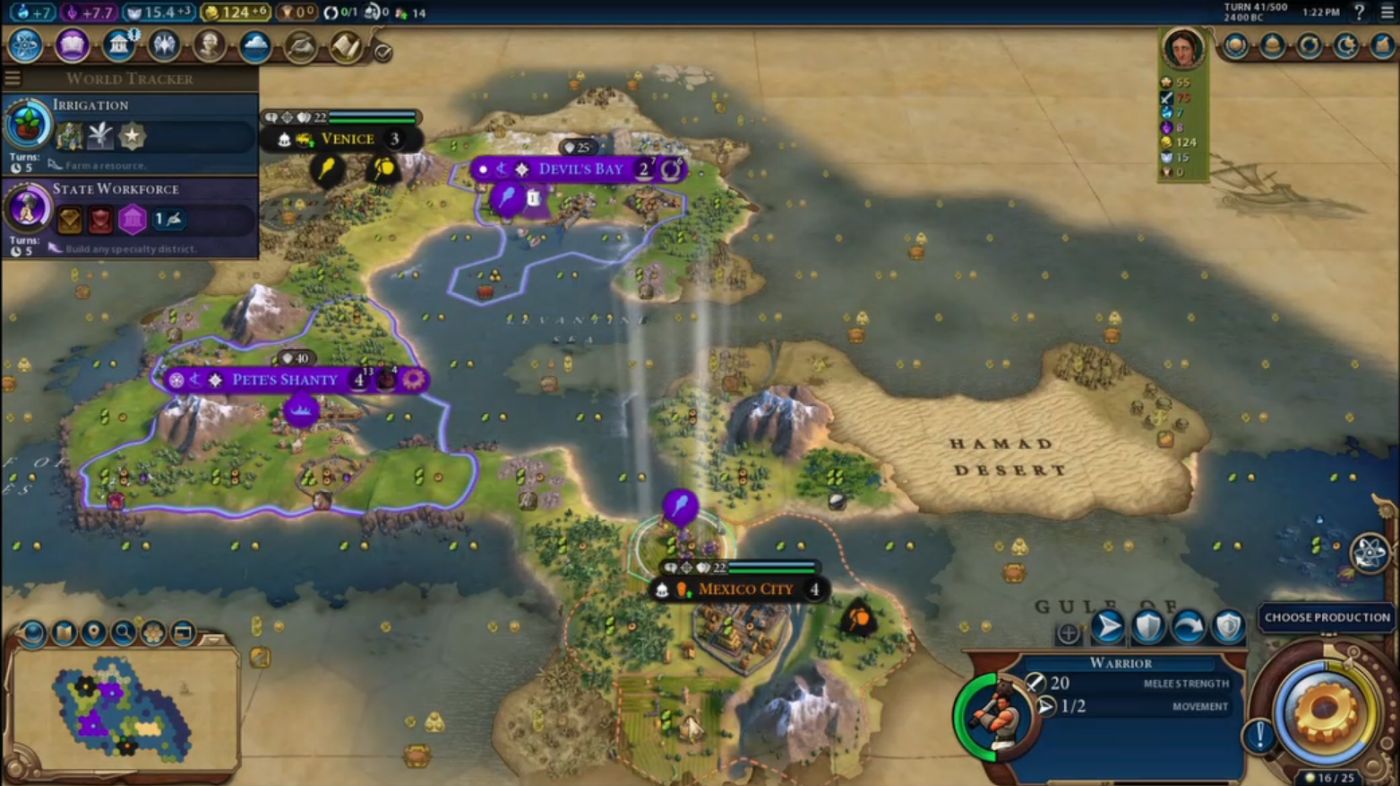
My overriding research goal for the early game was to unlock the Cothon district as soon as possible. This required reaching Celestial Navigation tech which can be a bit tricky since it's a Classical era tech and has an unusual quest (improve two seafood resources) associated with its boost. I actually made use of Phoenicia's unique civ ability whereby they start the game with Writing boosted, allowing me to finish the rest of the tech and construct a very early Campus district at the capital while the cost was still cheap. This also provided the boost for State Workforce civic and helped speed me along towards Political Philosophy and the first governments. I found that I was on a small enough island that there was little need for military and could focus purely on expansion. The downside was that I had little space to expand until my units could embark on water tiles. There was room for three cities, with one more to be placed north of Mexio City, and that was basically it. I'd have to acquire more tech before I could spread out across the map.
Having Phoenician biremes on hand was great, of course, and I built several of them to start defogging the rest of the map. They could find places for settlers to travel once I was able to embark land units at Shipbuilding tech. I soon ran into some of the other AI leaders in the game, with Wilhelmina of the Dutch and Gilgamesh of Sumeria located to the southeast along with Qin of China to the southwest. I also discovered the city state of Nan Madol in the deep south on another continent and this became the target of my envoy policy for the rest of the game: drop everything into Nan Madol to take and hold suzerainty while ignoring the other city states. Nan Madol grants +2 culture/turn for each distrct (and city!) placed along the coast, which would be basically everything on this Archipelago map. Every Cothon would be worth a free monument and I could basically ignore the cultural side of the game altogether while racing through the civics tree. Nan Madol was stupidly overpowered on this map and I was able to secure control of it pretty quickly and then hold its ownership for the rest of the game.
Unfortunately the science side of the research tree proceeded at a slower pace. There were no Scientific city states to be found anywhere on the map and my beaker rate was unimpressive even with Pingala in place. I soon found myself with a settler for my third city but I couldn't move it to the desired spot because Mexico City's borders had expanded to block the path forward and I wasn't able to embark land units on the seas as yet! I ended up having to declare war on the city state just to get my settler through to found the third city and then began the slow process of reducing its defenses. First I had to kill off the warrior spam that the city states produce and then start the siege of the city itself. The various city states all get free walls on Deity difficulty so it's a bit tougher than what we see in our Civ6 Multiplayer games where the city states tend to be sitting ducks. The Civ6 AI is an idiot though which meant it was only a matter of time spent shooting the city state with archers until it was ready to be captured:

Mexico City was renamed to Bloody Mountain in commemoration of the siege which had been bloody for the AI if not for me. It was a relief to have this annoying city state out of the way so that I could mostly focus on expansion. My military units turned around and headed up to the Commercial city state of Venice to complete the conquest of my starting continent even as the rest of my civilization turned to the overseas islands. The early returns were honestly pretty sad; I was blocked from expanding to the east by a wide ocean that my ships still couldn't cross at this point. There was more land over there but it was past the Dutch/Sumerian domains and a long ways off. In the other direction, the west held a series of smaller islands that were heavy on useless desert tiles. The only island that looked halfway decent was already claimed by another Commercial city state (Lisbon) and a Chinese city. I'd have to squeeze some settlers into the leftover gaps before the remaining territory was claimed. This was a real shame as I had the Cothon districts completed at this point along with the Ancestral Hall finishing up in Devil's Bay. I was all set for a big wave of settlers and I couldn't find good places to send them!
Further exploration revealed the last two AI leaders in this game, Peter of Russia and Jayavarman of the Khmer. They were the furthest AI leaders away from me and looked to be somewhere on the other side of the world. I had caught a bit of a break by having Gilgamesh drawn onto this map as he's the easiest AI to turn into a friend. We signed a Declaration of Friendship and later turned that into an alliance; I wouldn't have any problems with him for the rest of the game. The other AIs mostly disliked me although they were still dumb enough to give me lots of gold/turn deals for resources that I didn't need. Here in Gathering Storm they also like to spend money to purchase diplomatic favor which feels like a nearly-useless currency to me. I'd rather have gold in hand than slightly more votes at the next World Congress. This gave me tons of gold that I used to keep improving the growth curve of my civ with strategic rushed purchases.
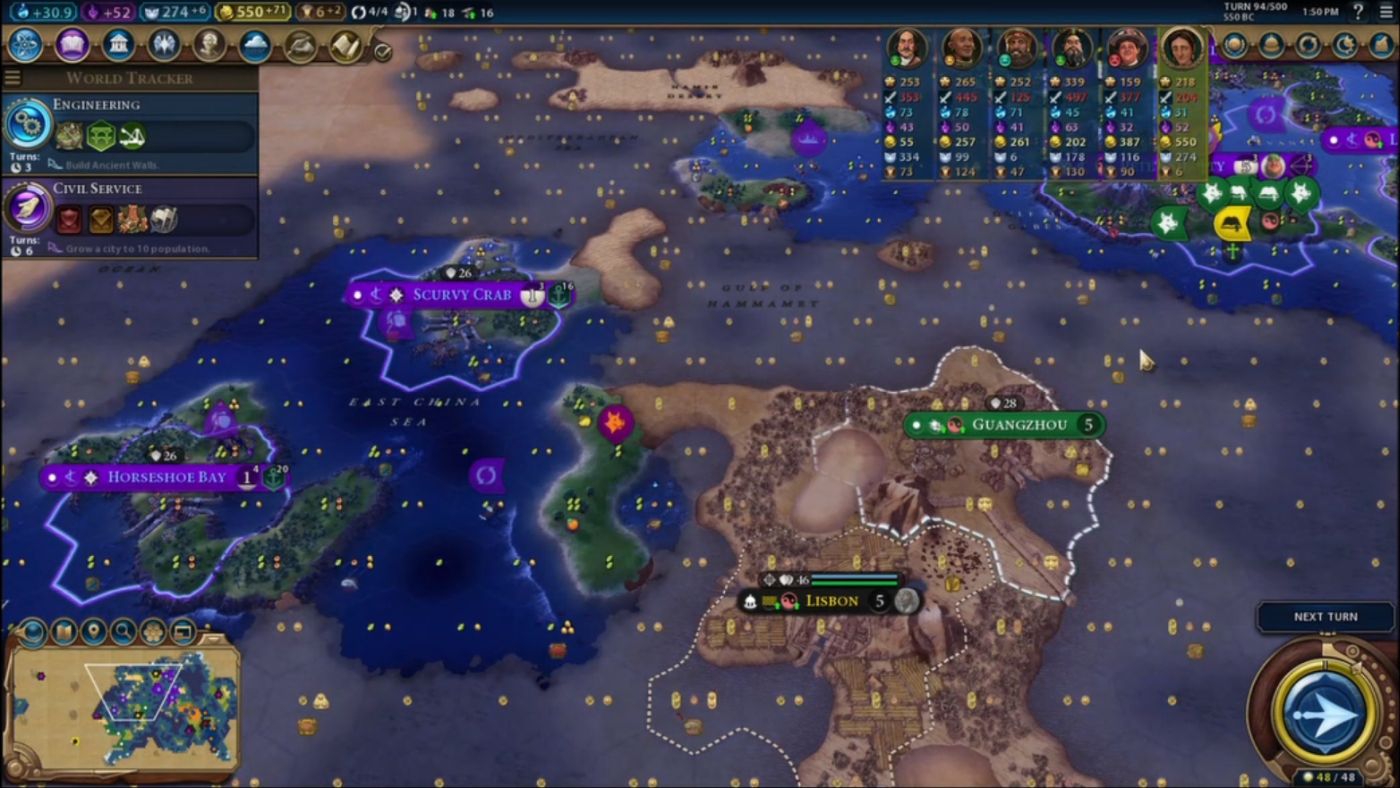
Scurvy Crab and Horsehoe Bay were the best locations that I could find for overseas expansion. I would later add the city of Jutland on the northern desert island by that citrus resource and another isolated city far off to the east past Dutch territory. Horseshoe Bay was a solid naval base with good local terrain but everything else was honestly pretty sad. I was making the most of these locations by building Cothons at each of them, the unique Phoenician district completing quickly in each case even at new cities. These settlements would each start out with a free builder thanks to the Ancestral Hall and then the Cothon would supply them with pretty much everything else that they needed. Harbor districts were a poor choice in the release version of Civ6 but they've been buffed so many times that they're now quite a bit better than their Commercial district rivals. Most of the Cothons were worth 3-4 gold/turn immediately thanks to their adjacency bonus from being located near seafood resources, and then the followup lighthouse building would add +3 housing (!) so long as the city center tile was next to the Cothon itself. Lighthouses would also add +1 food to all water tiles and unlock another trade route which made them must-have buildings. On top of that, Nan Madol would helpfully add +2 culture from the city center along with +2 culture from the Cothon. In other words, the Cothon basically provided everything that a city needed (food, gold, housing, culture, etc.) aside from science and I was doing what I could in that regard. Most cities were building Cothons and then Campus districts at size 4 and there really wasn't much of a need for any other districts other than those two.
Phoenicia is also a civ that's well positioned to take advantage of one of the Golden Age dedications. I didn't qualify for a Classical era Golden Age but did accumulate enough era score to unlock a Medieval one. This opened up the use of the Free Inquiry dedication: Commercial Hub and Harbor district gold adjacency bonuses provide science as well. I had zero Commercial districts but I had Cothons everywhere and turning their gold adjacency bonuses into beakers was worth a lot of science. Furthermore, this benefit can be doubled by running the Naval Infrastructure policy card (+100% Harbor district adjacency bonuses) for massive gold and science output. I think that I gained about 30 beakers/turn immediately when the Golden Age started and the benefit only kept going up as more cities finished their Cothons. We've seen a number of players make excellent use of Free Inquiry in our Civ6 Multiplayer games and it was certainly powerful here. The one downside is that this Golden Age dedication can only be used in the Classical and Medieval eras - you do have to construct Campus districts eventually!
Meanwhile, I mentioned before that my small military had gone off to capture the city state of Venice and finish clearing out my home continent. This took quite a while thanks to the city state popping out a sword and increasing its defensive strength to 40 (making archer shots almost useless). Eventually the siege succeeded though and Venice was rechristened as Ecinev under Phoenician control. This caused a side effect that I hadn't been expecting: the World Congress met in an emergency session and I was branded as an outlaw for capturing the city state. China and the Khmer declared war on me immediately in an attempt to restore the city state's independence. Argh, what a pain in the rear! I think the World Congress is pretty stupid overall and this was the worst kind of Single Player nonsense. I suppose that this was the penalty for selling off so much of my diplomatic favor in earlier trades but I would still have rather had the gold to spend anyway.
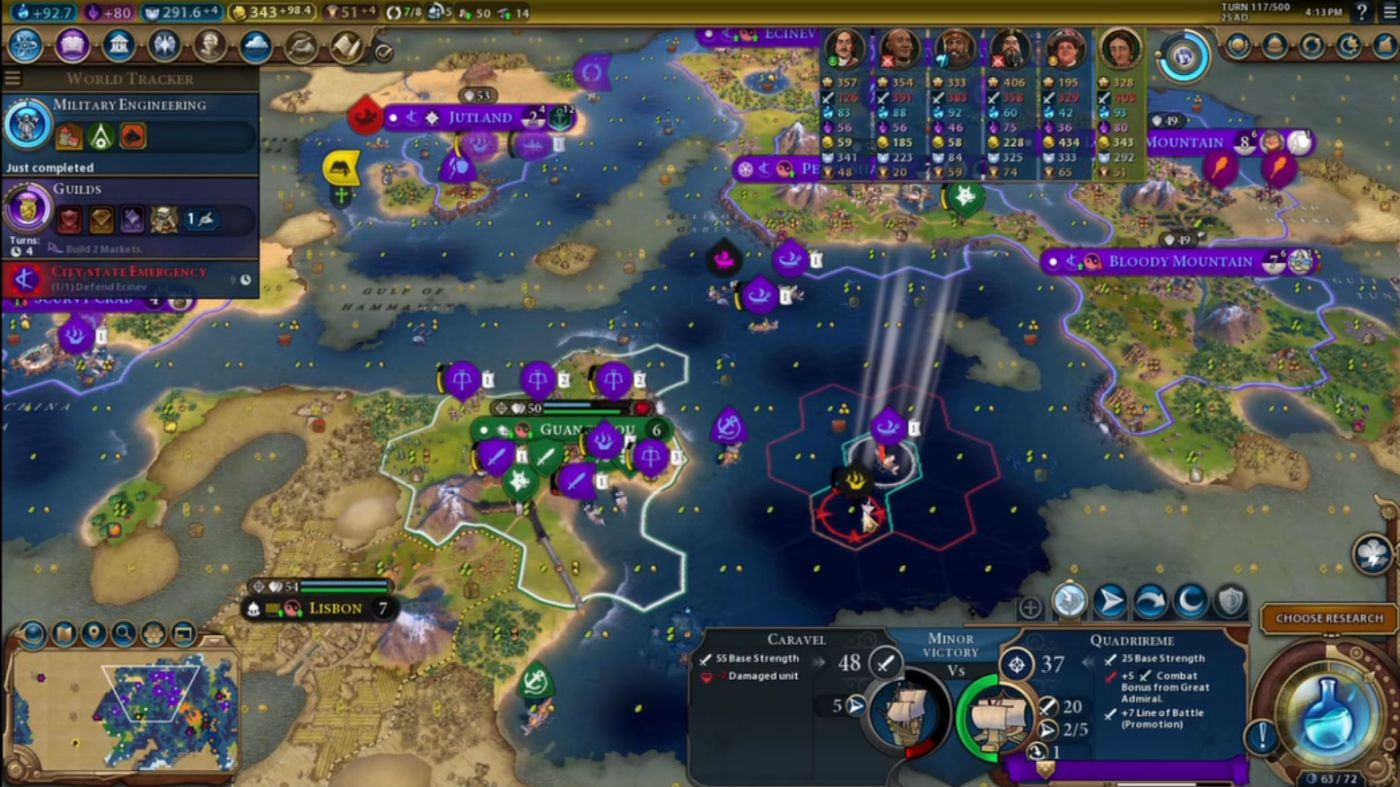
As a result, I ended up at war with two of the AI nations for the next 30 turns. I didn't even have visibility on any of the Khmer cities so I decided to focus on capturing the nearby Chinese city of Guangzhou. China itself was thoroughly pathetic and did the usual thing that the AI does while at war, embarking its land units and then sailing them around in circles aimlessly while my naval units cut them to pieces. The danger in this war came not from the main AI leaders but from their dispersed allies: the city states and the barbarians. The city state of Lisbon fielded a far more dangerous navy than anything that I saw from China, probably because all of its ships were magically upgraded as soon as the era changed. I had to exercise great care in defeating Lisbon's caravels which appeared on the scene before I had the corresponding technology to counter. (With enough quadrireme shots you can take down caravels in safety - having Great Admirals on hand was a big help.) Even worse were the barbarians which tormented me for ages on end. There was a barbarian camp in the northwest corner of Jutland's desert island and I could never get units up there to clear it because there was always a more pressing need elsewhere. That barbarian camp spewed out galleys and quadriremes, then caravels and even frigates in a steady stream until I could finally clear it many years later. The barbarians were much, MUCH more formidable than the AI leaders because barbarian units could pop up out of thin air anywhere on the map and they didn't have to play by the rules of the game (no need to come up with resource requirements or actually build the units in question). More on this later.
It ended up taking quite a while to gain control of the seas to the west of my starting continent. Eventually I was able to sink all of the city state ships and get the upper hand over the barbarians, then begin the slow process of grinding down the city walls at Guangzhou folled by Lisbon. City walls have been massively buffed in the expansions so that they take longer than ever to remove, a change that I don't agree with because it's already too difficult to capture cities in Civ6. I had enough units to conduct successful sieges in each case but it did take some time. Things were touch-and-go for a little while at my isolated island city in the far east which attracted a lot of attention from the Khmer. I had to rush-buy a crossbow in there for safety and I was able to get the city walls up just in time. That made the city effectively invincible, of course, since the AI has no idea how to capture any location on the map protected by walls. I don't think any of the AI leaders captured a single city from anyone throughout the whole game; it's genuinely sad how pathetic they are in this regard.

All good things have to come to an end and when the Medieval era concluded I lost the Free Inquiry dedication. This sent science plummeting as I lost about 50 beakers/turn, ouch! I had known this was coming and was building Campus districts wherever possible but it still hurt. We were shifting into the midgame naval units now and that meant that the era of caravels and frigates was underway. Frigates are noteworthy for being the first naval unit with a resource requirement and this is a place where the gameplay has changed significantly in the expansions. In the original version of Civ6, players needed two copies of a resource to train units associated with it (like needing two irons to train swords) or one copy of the resource if they had an Encampment district. Any additional copies of the resource beyond two had no effect. The expansions changed this dynamic by adding discreet resource quantities to the training of each unit. Swords require 20 iron apiece to train, for example, and each iron resource provides a certain amount of iron each turn. The lategame units even require per-turn resource consumption, like each tank needing 1 oil each turn to keep running properly. This creates an incentive for players to control as many of each resource as possible as there's a finite number of how many planes or tanks or modern ships that each player can build based on the resources under their control. It also put an end to the pre-expansion gameplay of building two dozen quadriremes and then mass upgrading them all into frigates instantly when the associated tech was unlocked. Even if the player has enough gold for the upgrades they'll never have enough of the strategic resources since there's a cap on how much can be amassed at any point in time.
The resource required by frigates is nitre and it's absolutely critical to control lots of nitre on a water map for the purposes of building frigates. If you can't keep pace with modern shipbuilding then expect to get crushed by those who can. I had terrible luck in terms of where nitre was located since it turned out that there were zero sources anywhere in my territory, even though Phoenicia was by far the largest civ by this point in time. The good news was that I had researched to Military Engineering tech and revealed nitre at an early date specifically so that I could find out where the resource was located and begin accumulating it. The bad news was that the only practical source nearby was found on this eastern wasteland island and blocked by a Khmer city. There were two nitre sources here and the AI city needed to be razed so that I could plant my own city for control of the resources. I had held off on signing peace with Jayavarman specifically so that I could destroy this annoying settlement and eventually I was able to smash through its non-walled defenses with a series of caravels. Then I had to fight off more barbarians in the lawless tundra before finally settling my own city of Nitreopolis to gain control of the resource. Once the nitre began flowing I could start upgrading quadriremes into frigates at a cost of 10 nitre apiece (using the policy card that cuts the resource requirement in half).

So this updated resource mechanic implemented in the Civ6 expansions is a nice idea overall and it creates real tension in the gameplay as competing nations battle for control of critical strategic resources. When humans are playing against one another in Multiplayer games, it works fantastically well. But as with seemingly every other mechanic in Civ6, there's a gigantic problem: the AI doesn't understand it at all. Not even a little bit, sadly. They have no idea how to work around strategic resources that they may be missing and very frequently can't field modern militaries for lack of nitre or coal or oil. This makes them even more ineffective against human players than they were previously and readers might recall that they were laughably bad even before the expansions came out. It's a little hard to tell in the images above but my military power had already climed higher than any of the AI civs, along with my culture (thanks Nan Madol!), and it was only a matter of time until science overtook the Khmer. They just... don't build very many units in Civ6 even on Deity difficulty and of course they have no idea what to do with the ones that they do build. The fact that the AI is completely incapable of threatening the human player in any way after the early game cheese rush is the biggest reason why I don't play more Civ6.
I did want to include the above image to highlight the power of my trade routes. My Medieval Golden Age had been followed up with a Renaissance Dark Age but that wasn't such a bad thing since it let me use the powerful Dark Age policy cards. I ran a little bit of the Twilight Valor policy which grants +5 combat strength to all melee units at the cost of being unable to heal outside your territory, not such a bad thing when nearly all of the fighting involves naval units that couldn't heal in neutral territory anyway. But the big winner for me was Isolationism: +2 food and +2 production for all domestic trade routes at the cost of being unable to train settlers or build new cities. There weren't too many places remaining on the map for cities to be placed so the settler penalty wasn't a big deal and I could always swap out of Isolationism temporarily to get a new city down. Meanwhile the trade route bonus was amazing, juicing up the yields to the pictured amounts. I was also running Triangular Trade policy for 4 gold and 1 faith per trade route, and anything sent to my original core cities could expect to pick up something like 4 food / 5 production / 4 gold / 1 faith per turn. This was perfect for getting new settlements up and running after which they would all build a Cothon + lighthouse pair and repeat the drill over again. I spent the whole game training more trader units to keep filling up the available trade routes and had something like two dozen of them crossing the map by the time it ended. This was the core economic engine that kept Phoenicia running.
Finally I had enough nitre connected to start upgrading my quadriremes into frigates. Once I had four of them out in the water, I declared war on the Dutch and...

...they collapsed like an overturned windmill. Wilhelmina didn't have walls protecting her cities and they simply melted under the bombardment of my new ships. If you can't read the little text in the image above, there were individual frigate shots for 51 damage and 64 damage on the interface. A single turn's worth of bombardment was enough to level Amsterdam and allow a caravel to perform the actual capturing. Wilhelmina had been completely pathetic in this game, faily utterly to expand and never getting past four cities. Recall that the Deity AIs start the game with two settlers so she manage to train exactly two of them over the course of 150 turns of action. (We learned on the postgame replay that she didn't even place her second city with the extra Deity settler until after Turn 50! What the heck - why are they so bad?!) The Civ6 AI has no defense whatsoever against a concentrated fleet and their tactical failures were becoming more and more apparent as time progressed. When they do build ships, they sail them around in random circles and can be easily picked off in isolation. And again, this was on top of the fact that the AI leaders struggle enormously to train ships like frigates and ironclads that have a resource requirement! The most dangerous threat at sea throughout the game was proving to be barbarian units and city state units, both of which ignore resource requirements and can pop up magically on the map. The actual AI civs put up no resistance at all.
Next I turned the fleet to the southwest and headed after the Chinese mainland down below the island of former Lisbon. Qin had walls defending most of his cities so it took a bit more time to reduce them one by one. However, he had no ships worth mentioning and therefore it was only a matter of time before each of them would fall. Anything that could be reached from the sea could not be defended from Phoenician ships. The only thing stopping me was the single worst mechanic in Civ6:

Loyalty, argh!  This is the idiotic mechanic added in the expansions that causes cities to revolt away from their owner if they lack enough "loyalty" to their nation. In practice it means that players can't settle on the borders of other civs and run a major risk of having captured cities revolt away from them. These Chinese cities proved to be extreme loyalty risks, located on another continent away from the rest of my cities and near the Chinese capital. I was also stuck in a Dark Age at the time which decreases the loyalty of your cities and that certainly didn't help. I wanted to keep Chengdu and Taiyuan because they controlled more sources of the precious nitre resource. But the loyalty situation here was absurdly bad: Chengdu was captured and then revolted away from me two turns later, I recaptured it and took Taiyuan, only to have BOTH cities revolt away again just two turns later. Seriously, what the heck?! How was this in any way fun? Did ANYONE want to see Civ3's culture flips return? China could not defend these cities, not at all, and yet I was prevented from holding them due to a mind-numbingly stupid game mechanic. There's no reason for loyalty to exist and if we ever put together a Realms Beyond mod for Civ6 it's going to be the first thing eliminated.
This is the idiotic mechanic added in the expansions that causes cities to revolt away from their owner if they lack enough "loyalty" to their nation. In practice it means that players can't settle on the borders of other civs and run a major risk of having captured cities revolt away from them. These Chinese cities proved to be extreme loyalty risks, located on another continent away from the rest of my cities and near the Chinese capital. I was also stuck in a Dark Age at the time which decreases the loyalty of your cities and that certainly didn't help. I wanted to keep Chengdu and Taiyuan because they controlled more sources of the precious nitre resource. But the loyalty situation here was absurdly bad: Chengdu was captured and then revolted away from me two turns later, I recaptured it and took Taiyuan, only to have BOTH cities revolt away again just two turns later. Seriously, what the heck?! How was this in any way fun? Did ANYONE want to see Civ3's culture flips return? China could not defend these cities, not at all, and yet I was prevented from holding them due to a mind-numbingly stupid game mechanic. There's no reason for loyalty to exist and if we ever put together a Realms Beyond mod for Civ6 it's going to be the first thing eliminated.
So I had no choice but to raze both cities to the ground since they kept revolting endlessly. Is this what the designers really wanted? For the player to have to act like a genocidal maniac by putting thousands to the sword because the loyalty mechanic gives them no other choice? It makes no sense. Anyway, I wiped Chengdu and Taiyuan off the map and replaced them with my own self-founded city a few turns later once the loyalty pressure had eased by taking the Chinese capital. Qin certainly wasn't doing anything at all to resist the Phoenician advance, nothing aside from moving a handful of units around in insane spinning patterns while they were shot to death with frigates. There was one Chinese city that proved to be inaccessible by sea and I felt no fear in moving my whole military away from the captured Chinese capital even though Qin could theoretically menace it with his units. Something as complicated as "walk units up to the captured capital and attack it to take it back" was apparently beyond the AI programming.
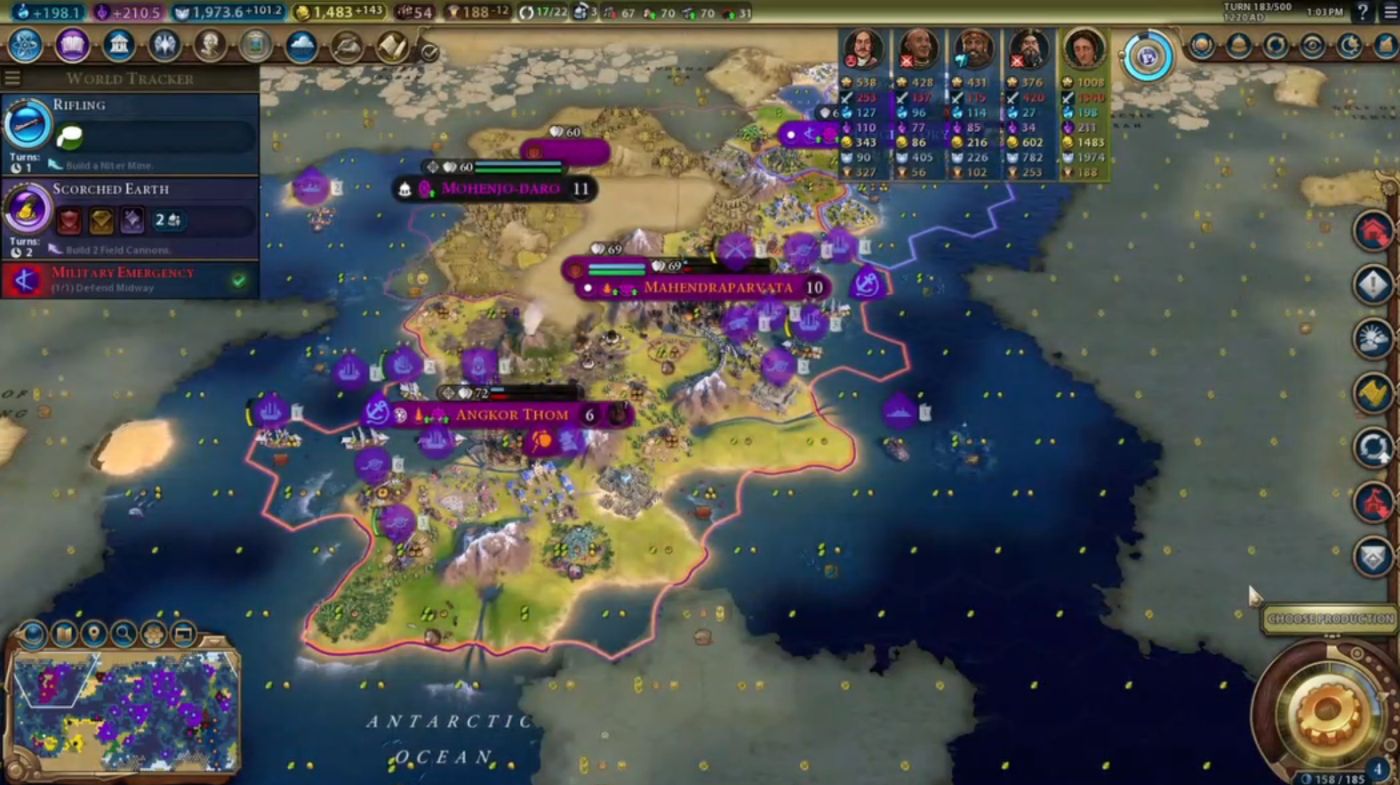
It was the Khmer who were next on the chopping block now that China had been cut down to size. I'd finally found Jayavarman's starting island and I was eager to get revenge on a civ which had spent most of the previous 100 turns at war with me. The brief interval of peace that I'd enjoyed with Jayavarman had been ended by some other World Congress emergency session that plunged me right back into war with him again. He put up no more resistance than Qin as my navy occupied both coasts and shelled the Khmer cities into oblivion. I was working with frigate fleets by this point thanks to unlocking the ability to combine units at Nationalism civic plus I had about a million Great Admirals thanks to having so many Cothons. Some of my frigates were also getting very highly promoted thanks to all of the fighting that they'd been doing. Frigates have a base ranged strength of 55 and by combining them into fleets (+10 strength) and having a Great Admiral (+5 strength) and adding their promotions, they were attacking at close to 80 ranged strength most of the time. It didn't matter how many combat strength cheats the AI was getting on Deity, they had no way to contest my control of the seas and the Khmer cities rapidly fell. Jayavarman avoided elimination only by virtue of having an interior city that my ships couldn't reach which wasn't worth trying to capture.
The fleet sailed directly south from Khmer territory and razed its way across a midsized island which had been split between several nations. I captured the last city there so that I could use its borders to start upgrading my frigates into battleships. They were the next tier of naval ranged unit which had just unlocked at Refining tech and represented another massive leap in combat strength. Battleships have a base ranged strength of 70 and - more importantly - three range as opposed to two range. This lets them set up for bombardment outside the range of city defenses, or alternately, pack even more ships together to focus on an individual target. Frigates are often limited by the total number of tiles available that can hit a defending city but this is much less of an issue for battleships. The assembled fleet looked like this as it assaulted Russia:
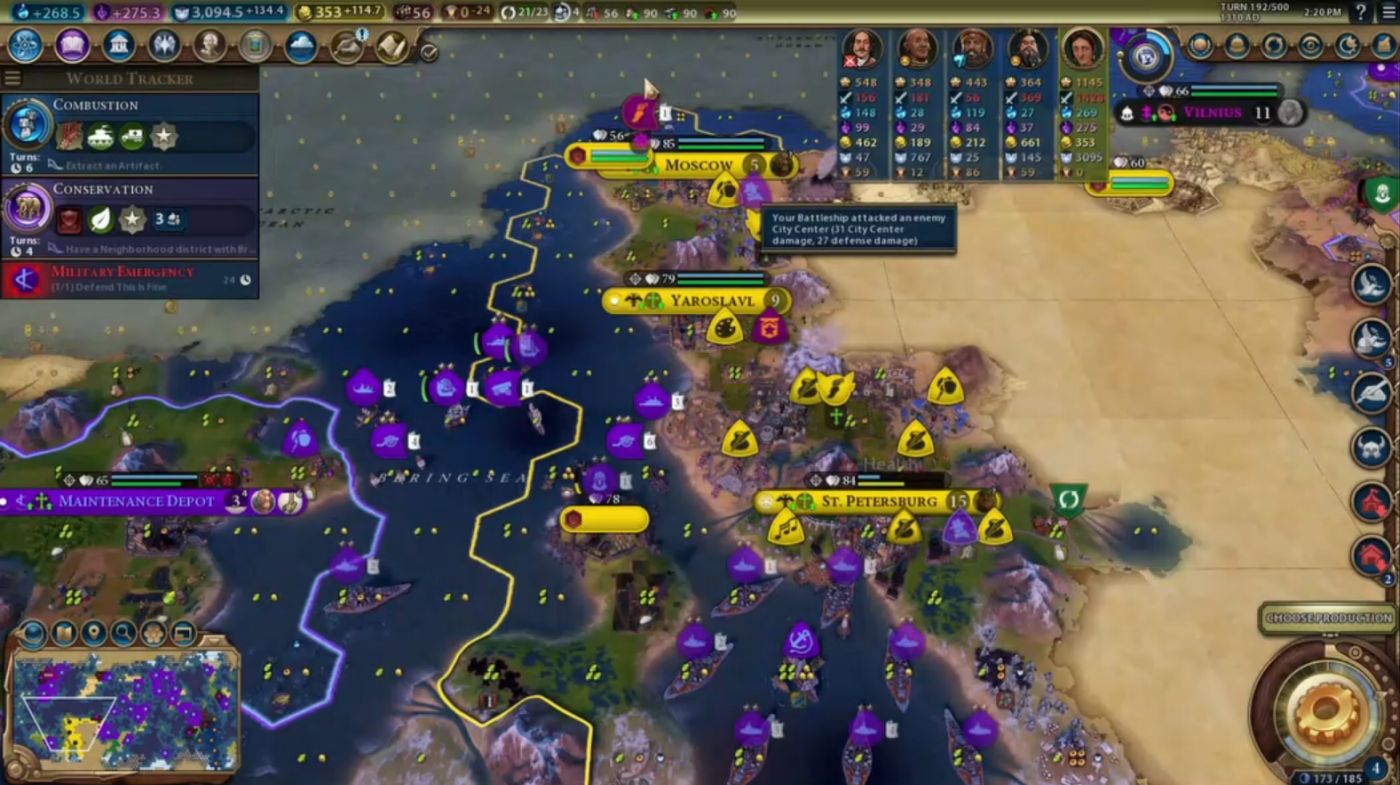
Peter seemed to be defending his territory a bunch of Great Writers from his Lavra districts; actual military units were nowhere to be seen. I crammed seven or eight battleship fleets into the narrow body of water south of St. Petersburg and blasted the living daylights out of the Russian capital. There was no more response here from the AI than there had been from the last few conquered nations and all of the Russian coastal cities were captured or razed over the next few turns. To be fair though, it would have been almost impossible to do anything about an enemy fleet once it reached this size. I was straining at the absolute limit of the battleships that I could support; each of them cost 1 coal per turn to maintain and I was running a coal deficit as the interface in the screenshot above indicated. Coal was a scarce resource on this map and I had settled every location that I could find along with running the policy card that added 1 coal/turn from each coal deposit under my control. It was just barely enough as I was able to stabilize at -1 coal/turn with about 30 coal remaining in the stockpile. The game would end before my civ could run out of the stuff. Like I said before, this is a neat mechanic but the AI cannot handle it at all, and it really makes any kind of military exercise in the latter stages of the game a complete joke.
The only remaining leader with an intact capital was Gilgamesh. He'd been an amazing ally throughout the game but unfortunately I did need to take his capital to put an end to this venture. When our alliance came up for renewal at the tail end of the Russian campaign, I deliberately did not sign up for another 30 turns of peace. Gilgamesh came asking for a new Declaration of Friendship and I selected "Sorry but we just can't commit to a formal friendship at this time." That should have been a clear rejection, right? But somehow Civ6 interpreted this response as signing up for a new 30 turns of friendship - what in the world?! We didn't catch this until two turns later and I was forced to reload and replay several turns to undo this bizarre result. Somehow the game's coding interpreted a "No" response to mean "Yes". What a game. 
Once I was actually able to declare war against Gilgamesh, that was all she wrote. My battleships sailed up to the Sumerian coast and annihilated Gilgamesh's cities, then a musket disembarked and walked into his undefended capital. Game over.
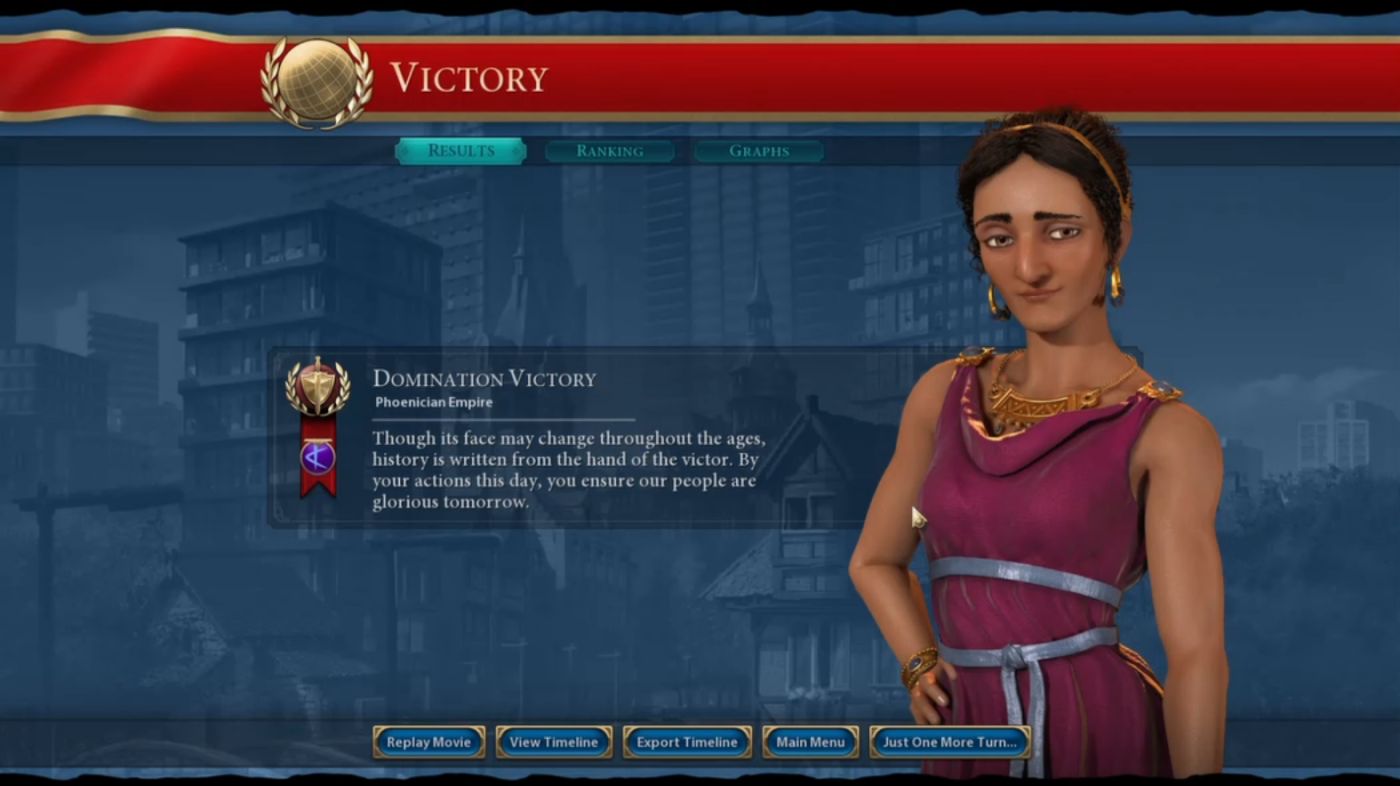
This was my first Domination victory in Civ6 and I'm a bit at a loss for words. The Civ6 gameplay does a lot of things really well, between the city building using districts and the policy cards and the tactical combat. When I can isolate the Civ6 gameplay solely to what I'm doing with my own civ, it's a lot of fun to play. The problem is that this isn't a sandbox game like SimCity, it's a competitive game between different nations, and there's essentially no opponent to play against when it comes to Civ6 Single Player. The AI is just terrible at this game and can't pose a serious threat to anyone who knows what they're doing. As I wrote back for the non-expansion gameplay, the AI can't mount a successful attack against the player, the AI can't mount a successful attack against other AIs, and the AI can't develop its own empire. The net result is a Single Player setup that feels barebones and lacking, with even the highest difficulty level failing to provide much of a challenge. I wish that Firaxis would prioritize creating an AI that can actually play the darn game rather than more and more downloadable content to sell off piece by piece. Our Civ6 Multiplayer games have shown that there's a pretty good game here... but only when humans are playing against other humans. It's really a shame.
I don't expect to spend too much more time playing Civ6 on Livestream due to these problems. It's fun to break out occasionally as a change of pace though. Thanks again for reading!



